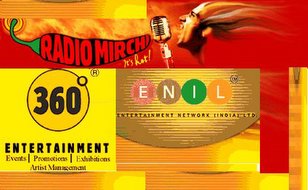IPO - Initial Profit Opportunities

Entertainment Network (India) Ltd.
Strengths
- As compared to other developed and developing countries, advertising on radio has not been popular in our country. However, as consumerism in the country is on the rise, this medium can increase its advertisement share faster than other media as it is the cheapest mode of advertising and has a low base.
- As opposed to the old licensing policy, which had a provision of a flat 15% escalation of license fee per annum, the new policy provides for performance-based revenue sharing. This provides good opportunity for ENIL to expand rapidly to capitalise on its first mover advantage.
- ENIL has the largest radio network in the country: seven major cities including four metropolitan cities. The company operates in the same 93.5 MHz frequency band in all the four metros, giving it an advantageous position among frequently traveling listeners. Also, by having a pan-India presence, ENIL enjoys the advantage of providing greater advertising coverage to its clients. The brand, Radio Mirchi, is well recognized in the market, with 95% and 100% brand awareness in Mumbai and Delhi, respectively.
- The Times group enjoys rich patronage from advertisers due to its deep presence in the media and publication business, giving ENIL an edge compared to its competitors.
Weaknesses
- The entertainment and media industry is very much people-centric. Attrition rate will increase with the entry of many players after the new liberal licensing policy. This may put tremendous uncertainty on the listener-hold of existing channels.
- A substantial portion of the issue proceeds will go to bid for new stations. The revenue and profit from such new ventures is subject to uncertainty and gestation periods of varying degrees.
- ENIL is involved in a host of litigations relating to the sources of its contents. Any ruling against the company can have material financial implications.
- The 100% subsidiary of ENIL is engaged in event management and out-of-home business, where many unorganised players have a good presence, raising uncertainty on growth and profitability.
Valuation
In the half-year ended September 2005, ENIL reported sales of Rs 48.37 crore and net profit of Rs 11.05 crore. The company earns higher revenue and profit in the second half of the financial year due to the festive season. However, in the half year, it has not provided for around Rs 4 crore of amortisation charges related to one-time fee payable to shift to the new licensing regime. Its debtors amount to Rs 37 crore. As ENIL will be spending above Rs 70 crore for acquiring new licenses, it will have to take further hit on amortising these charges, as the new cities will take time to bring revenue. So one can not expect big EPS numbers in the short to medium term and P/Es will be high. Being the only listed player (at least for some time) in this field will stand it in good stead post-listing.

Jagran Prakashan Ltd.
The objective of the issue is to raise finances for a capital expenditure of Rs 274.33 crore required to enhance its printing and publishing capabilities, to consolidate its infrastructure including printing facility and the editorial, marketing and administrative departments and launch a second brand. In addition to this, Jagran Prakashan also intends to use around Rs 43.39 crore from the public offer for acquisitions and investments in order to build a strong competitive force in its area of operation. Besides, there are plans to spend Rs 40 crore to expand its outdoor advertising business. The Promoters and Associates also own Channel 7 and Rave Entertainment Private Ltd. which operates a multiplex in Kanpur at present. All in all a good offer to subscribe.
- Despite a number of broad-page English and Hindi dailies such as the Times of India, Hindustan Times, Dainik Bhaskar and Navbharat Times. Dainik Jagran has maintained its leadership, commanding a readership of 21.2 million per day. Readership of Dainik Jagran increased by 120.8%, from 9.6 million as per NRS 2000 to 21.2 million as per NRS 2005. This increase in readership was more than the combined growth of readership in the next four of the top five newspapers and was more than three times the growth in readership of the top six English daily newspapers. The growth in the readership and circulation reflected in the top line of the company, which shows a CAGR of 19% in the last five years to Rs 371.46 crore in FY 2005.
- More than 60% of the revenue in FY 2005 and six months ended September 2005 comes from advertising, which is the mainstream of revenue for any company in the print media industry. Ad-spends in India, as a percentage of GDP, is only 0.34%, which is very low compared to countries like Thailand (1.43%), China (0.54%), and Mexico (0.52%). Along with the fast growing GDP, India’s ad-spend as percentage to GDP is also expected to increase to 0.54% of GDP by 2015. Print media accounts for around 46% of the total advertisement spend. As Dainik Jagran has a pan-India presence and its expansion initiatives on various fronts are likely to strengthen its position, it can expect to grasp a larger share of ad-spend in India.
- Expanding printing capacity, particularly colour capacity, and modernising and upgrading existing printing centres in Noida are in addition to installing computer to plate (CTP) printing at some printing centres. The new modern printing facility will increase the ability to print color copies by fourfold. With this, ad rates are expected to go up. As colour advertisement is at a 70% premium to black-and-white ads, margin will be higher
Weaknesses
- On its strong foothold in the vernacular segment, Dainik Jagran’s revenue has shown robust CAGR of around 19% in the last five years to Rs 371.46 crore in FY 2005. However, in the same period, Jagran Prakashan’s bottom line has shown a negative CAGR of around 31% to Rs 1.54 crore mainly on high prices of newsprint, which is the main raw material for the company. The operating margin has kept fluctuating in the last five years, witnessing a low of 1.6% in FY 2002. According to BMO Financial Group Commodity Price Index, the international newsprint prices are forecast to move up to $645 per tonne by 2007, from $609 per tonne in 2005.
- The capital expenditure plans are likely to be commissioned only between March 2007 and March 2008 and yield benefits from FY 2008 onwards.
- Jagran Prakashan intends to venture into outdoor advertising and also launch a second brand, a Hindi tabloid in line with the Times of India's recent English tabloid, Mumbai Mirror. Around Rs 43 crore and Rs 40 crore from the issue proceeds will be invested in launching the tabloid and expanding the outdoor advertising business, respectively. Looking at the existing players in these businesses, Jagran Prakashan will have to face tough weather, at least in the initial years of operation, till the time the new businesses find acceptability in the market.
Valuation
FY 2005 was one of worst years for Jagran Prakashan as its operating profit margin (OPM) crashed by 720 basis points (bps) to 5.6%. Net profit was just measly Rs 1.54 crore on sales of Rs 371.54 crore. However, financial performance has improved, with the six months ended September 2005 OPM up by around 600 bps to 11.5%, leading to improved net profit of Rs 11.97 crore. Annualised six-month EPS on post-issue equity works out to Rs 4.6.The offer price band of Rs 270-324 discounts this 58 to 70 times. On the other hand, HT Media, which has revenue almost double the revenue of Jagran Prakashan, with better profitability margin, trades at a PE of around 62 times its annualised half-yearly EPS of Rs 7.6. Another listed player, Deccan Chronicle, trades at a PE of 27 times the first-half annualised EPS.
Notably, INM had acquired a pre-issue 26% equity stake at Rs 144 per share (adjusted for bonus) in June 2005, which is at a 50% discount to the current offer price band. Post-issue, INM will hold a 20% stake, leaving scope for only another 6% foreign stake as the cap for foreign stake in the print media is 26%.













0 Comments:
Post a Comment
<< Home